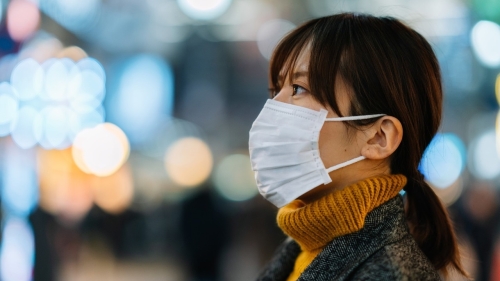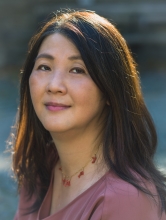Targeted by discrimination and violence during COVID-19, many grapple with questions of identity and belonging.

Getty Images
Since reports first surfaced that the COVID-19 pandemic originated in Wuhan, China, the US has seen troubling waves of anti-Asian discrimination and violent attacks nationwide. In an urgent study now underway, Doris F. Chang and Sumie Okazaki, professor of applied psychology, are exploring how Asian Americans are responding.
To investigate how fear and dismay are affecting the diverse Asian diaspora, Chang, associate professor at NYU’s Silver School of Social Work, and Okazaki are currently analyzing a national sampling of 692 Asian American adults, and they aim to complete their CARA (COVID-19, Asian-Americans, Resiliency, and Allyship) Study this spring.
According to the researchers, this latest bout of xenophobia and hate crimes has crystallized a long-enduring reality—the prevalence of racism in the US and its impact on this minority group. The survey data suggest that pandemic-related incidents have unsettled the sense of belonging that people of Asian descent had felt was secure. It shows, too, how anti-Asian physical assaults, such as the shoving of a 91-year-old man in Oakland’s Chinatown, as well as a surge in anti-Asian sentiments online, have stirred anxieties as well as activism.
Chang and Okazaki also find that George Floyd’s murder by police and the Black Lives Matter protest movement intensified the soul-searching among Asian Americans about their civic identity, and spread a parallel awareness of personal and structural biases undermining status, opportunity, and safety.
“The rapid assessment of this data while the effects of the pandemic and the protest movement are being felt will set the stage for future research on the short- and long-term impact of race-related stress and the politicization of Asian Americans to fight for racial justice,” says Chang, a fellow at the Asian American Psychological Association whose research centers on improving the well-being of racial and ethnic minorities. Co-investigator Okazaki’s work explores the impact of immigration, social and cultural change, and race on Asian American adolescents, young adults, and parents.
Nearly a year after March 11, 2020, when the World Health Organization declared COVID-19 a global pandemic, NYU News spoke with Chang and Okazaki about the study, which is funded by an NYU Silver seed grant.
Q. For the purposes of your study, how do you define “racial trauma"?
Doris Chang: We define it as a type of traumatic stress experienced by Black, Indigenous, and People of Color in response to actual or perceived risk of harm or discrimination based on race, and it may include exposure to race-related threats, insults, microaggressions, invisibility, and marginalization—directly experienced in face-to-face interactions, online, or vicariously through the experiences of others.
Q. In what ways has the COVID-19 pandemic been particularly traumatic for Asian Americans?
Chang: While African Americans are more exposed to racial discrimination than are other racial and ethnic minority groups, Asian Americans, too, have a long history of being discriminated against and targeted as “perpetual foreigners” who pose an existential threat to Whites, as economic or academic competitors, or as imagined threats to national security—consider the mass internment of Japanese Americans during WWII. The Covid-19 pandemic, and the political rhetoric that persists in blaming the Chinese, has triggered these latent stereotypes.
A rise in anti-Asian harassment and violence has been directed toward Asian Americans and Pacific Islanders since the start of the pandemic. Between March and December 2020, Stop AAPI Hate received 2,808 firsthand reports of anti-Asian incidents from 47 states and the District of Columbia, about 70 percent of which were verbal harassment, 21 percent involved shunning or avoidance, 6 percent involved being coughed or spat on, and 9 percent involved physical assaults.
Q. Part of the problem, I imagine, is the long-time stereotyping of Asian Americans—in cinema, sit-coms, and the news.
Chang: All of these are part of the Asian American narrative, absolutely. Representations of Asians in the US have tended to vacillate between portrayals of invisibility and one-dimensionality (as in movies and TV), Asians as alien and “other” (as in the model minority myth), or as existential threats (the “Yellow Peril”). Particularly in moments of social and economic instability, Asian Americans become convenient targets, and the about-face can be quite staggering. A recent Twitter study by Melissa Borja from the University of Michigan and colleagues found that tweets that used stigmatizing rhetoric like “the Chinese virus” all came from Republican politicians, with former President Trump being the worst offender.
Sumie Okazaki: One of the insidious aspects of the model minority myth is the belief that Asian Americans do not “complain” about their unfair treatment. Historically, this stereotype entered public discourse around the Civil Rights Movement when Black and Brown communities were organizing, protesting, and advocating for their rights. Many Asian American activists also joined in this coalition of people of color to work toward greater equality, but there was a divisive counter-narrative that Asian Americans were uncomplaining (meaning non-protesting) minorities who were able to pull themselves up by their bootstraps by the dint of their hard work, and therefore should be a “model” to other minority groups. Unfortunately, some Asian immigrants also buy into this anti-Black narrative, and strive to keep their heads down and focus solely on their own economic mobility. The model minority myth persists to this day, with the perception that Asian Americans are easy targets for racial attacks because they are seen as unlikely to vocalize and organize in protest.
Q. Would you describe your methodology?
Chang: We administered a survey to nearly 700 Asian American respondents across the country, recruited through a survey research company. The sample is quite diverse, with 24 different Asian ethnic groups represented, including Chinese (33 percent), Filipino (12 percent), Indian (13 percent), Japanese (11 percent), Vietnamese (10 percent), and Korean (8 percent). We used standardized measures, and adapted a few others, to assess COVID-19-related racial discrimination, pandemic stress, psychological distress, worry, symbolic racism, linked fate, racial/ethnic identity, and resistance and empowerment against racism.
Q. You also address the impact of the Black Lives Movement on Asian Americans. What connections are you seeing?
Okazaki: Asian American communities are enormously diverse, and I don’t think there is any singular Asian American reaction to the killing of George Floyd and more generally to the national reckoning with anti-Black racism. And, of course, there has been a long and complex history of Asian-Black relationships. The fact that one of the police officers at the scene complicit in the killing of Mr. Floyd was of Asian heritage (Hmong-American to be precise) has caused a multitude of reactions among many Asian Americans—anger, indignation, shame, introspection and so on—as his presence gets at the heart of many questions for Asian American communities: Are we complicit in perpetuating anti-Black racism, even as we face anti-Asian or xenophobic racism ourselves? Can we be allies and accomplices for dismantling anti-Black racism? Our study does include questions regarding Asian American respondents’ attitudes toward, as well as sense of solidarity with, other immigrants and with African Americans, among many other things. We plan to examine how Asian Americans respond to the larger racial climate and to anti-Black racism.
Q. Are you detecting any patterns?
Chang: We’ve found that COVID-related discrimination is quite common, with respondents reporting an average of one-to-two incidents a month since January 2020. We were surprised to find that East Asians in our sample reported less direct discrimination (online and in person) compared to Southeast Asians and South Asians, despite the stigmatizing rhetoric which focused on China and later extended to other East Asian countries. We’ve also found that the more COVID-related discrimination individuals reported, the higher their levels of psychological distress and worry, with Southeast Asians and South Asians experiencing higher levels of distress relative to East Asians.
Finally, individuals who reported higher levels of COVID-related discrimination also tended to agree that racial discrimination remains a serious problem for Black Americans, and engaged more in activities associated with resistance and empowerment against racism. One way to think about this is that Asian Americans who had more experience of being a target of discrimination tended to be more aware of the systemic nature of racism that unites Black Americans, Asian Americans, and other ethnic minority groups, and were more likely to be engaged in actions aimed at challenging that system.
Q. Yet research on racial trauma has tended to bypass the experience of Asian Americans compared to that of other US minorities, has it not?
Okazaki: The lack of visibility of racial trauma research with Asian Americans isn’t necessarily related to the highly justifiable volume of racial trauma research concerning the experience of Black Americans. I think there should be more of both! There has been excellent research and theory development with respect to the particular contours of racial trauma within various segments of Asian Americans, such as Donna Nagata’s work on intergenerational trauma and silence around Japanese American internment, and E. J. R. David’s work on colonial mentality (a specific form of internalized racism) among Filipino Americans, and David Eng and Shinhee Han have theorized about racial melancholia among Asian Americans, to name a few. That said, as violent attacks against Asian Americans — including recent horrific attacks on Asian elders— continue unabated, the emerging research on the impact of racial trauma on Asian Americans must be sustained.
Q. Let’s return to the concept of a “model minority,” since it seems particularly prevalent. What does your research tell you about its impact?
Chang: We know that some Asian Americans have internalized the idea that we are a “model minority” that is somehow exempt from the systemic racism that affects other groups. This idea is obviously inaccurate, divisive, and harmful in many ways. So we’re excited to have the data now to try to understand how factors such as ethnicity, class, political affiliation, geographic location, and features of the communities that they live in shape Asian Americans' experiences of and responses to racialization. We hypothesize that these socio-ecological factors all inform the degree to which Asian Americans are finding common cause with Black Americans and other marginalized groups and working to end racism for the benefit of all.
Okazaki: I agree. And I’d just add that the segment of Asian Americans who were opposing affirmative action for other minorities in college admissions, or were resisting school desegregation efforts, is a vocal minority. The majority of Asian Americans support affirmative action and other racial equity initiatives. That said, any discussion of Asian Americans is fraught with the danger of overgeneralization, even while we aim to understand what keeps Asian Americans connected to each other and to form solidarity with Blacks and Latinx and Native communities. We hope to examine the multitude of Asian American experiences with nuance and complexity in our research.

